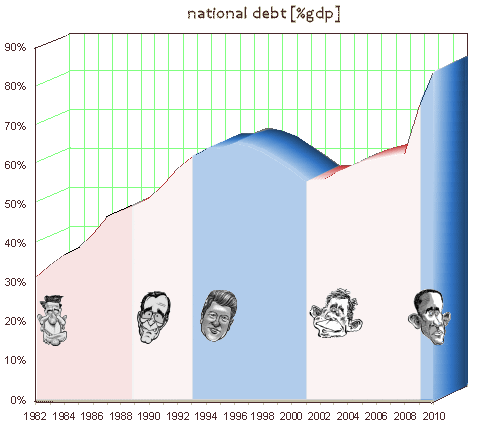Recessions are common; depressions are rare. As far as I can tell, there were only two eras in economic history that were widely described as “depressions” at the time: the years of deflation and instability that followed the Panic of 1873 and the years of mass unemployment that followed the financial crisis of 1929-31. Neither the Long Depression of the 19th century nor the Great Depression of the 20th was an era of nonstop decline — on the contrary, both included periods when the economy grew. But these episodes of improvement were never enough to undo the damage from the initial slump, and were followed by relapses. We are now, I fear, in the early stages of a third depression. It will probably look more like the Long Depression than the much more severe Great Depression. But the cost — to the world economy and, above all, to the millions of lives blighted by the absence of jobs — will nonetheless be immense.
And this third depression will be primarily a failure of policy. Around the world — most recently at last weekend’s deeply discouraging G-20 meeting — governments are obsessing about inflation when the real threat is deflation, preaching the need for belt-tightening when the real problem is inadequate spending. In 2008 and 2009, it seemed as if we might have learned from history. Unlike their predecessors, who raised interest rates in the face of financial crisis, the current leaders of the Federal Reserve and the European Central Bank slashed rates and moved to support credit markets. Unlike governments of the past, which tried to balance budgets in the face of a plunging economy, today’s governments allowed deficits to rise. And better policies helped the world avoid complete collapse: the recession brought on by the financial crisis arguably ended last summer.
But future historians will tell us that this wasn’t the end of the third depression, just as the business upturn that began in 1933 wasn’t the end of the Great Depression. After all, unemployment — especially long-term unemployment — remains at levels that would have been considered catastrophic not long ago, and shows no sign of coming down rapidly. And both the United States and Europe are well on their way toward Japan-style deflationary traps. In the face of this grim picture, you might have expected policy makers to realize that they haven’t yet done enough to promote recovery. But no: over the last few months there has been a stunning resurgence of hard-money and balanced-budget orthodoxy…
It’s almost as if the financial markets understand what policy makers seemingly don’t: that while long-term fiscal responsibility is important, slashing spending in the midst of a depression, which deepens that depression and paves the way for deflation, is actually self-defeating… And who will pay the price for this triumph of orthodoxy? The answer is, tens of millions of unemployed workers, many of whom will go jobless for years, and some of whom will never work again.
I will never claim to get Keynesian economics. It’s a mixture of math and ideas about mass financial psychology that are simply larger than my brain can hold. But I get that it is counter-intuitive, and that may well be its essence. During hard times, people hold on to their assets, spending less, hiring less – they become fiscal conservatives. Values fall and currency stops flowing. A Recession is the result. A Depression is the situation that follows when this usually cyclic phenomena becomes chronic, and the whole economy grinds to a halt. The Gospel of Krugman [channeling Keynes] has been invariant since the collapse in September 2008. He encouraged the Stimulus Package, but wrote endlessly that it was too small. Subsequently, he has been unwavering in predicting a prolonged slow-down. His solution is to pour money into the economy to get people working again [the old metaphor being "prime the pump"].
World War II: I suppose that the best example in recent history is our own. F.D.R. followed Herbert Hoover and acted like a Keynesian with his New Deal. But in his second term [1937], he backed off, secumbing to either his own fears or pressure from outside [his cold feet period]. We had another Recession that lasted until the outbreak of World War II when we cast caution to the wind and ran up the debt to unequaled heights. I guess one way to think about it is to suppose we had just pretended there was a war – built all those military machines, then sunk them in the ocean. Would the result have been the same? Did it even matter that we needed them? It got people back to work and restarted the economy, that’s what mattered.
Stimulus along the Nile: We venerate the ancient Pyramids and Temples along the Nile. What an achievement! Yet their purpose seems trivial – tombs, monuments to gods and rulers, narratives about an afterlife reserved for the elite. Who cares? On our visit there this winter, we were awed as is everyone always is, but again –  who cares? Several guides told the same story. Until the building of the Aswan Dam, the yearly flooding of the Nile delta was variable. In dry times, there was no flooding; no restoration of the soil; poor to no farming. During those times, the farmers went to work for the government, building Pyramids and Temples. So they may have had a real purpose after all – economic stimulus. I guess it was like the WPA and the CCC. Keep them working during hard times. I don’t know if that story about Egypt is true, or whether such things can really be deduced this far after the fact, but I still like the story. It makes sense out of something that’s otherwise illusive.
who cares? Several guides told the same story. Until the building of the Aswan Dam, the yearly flooding of the Nile delta was variable. In dry times, there was no flooding; no restoration of the soil; poor to no farming. During those times, the farmers went to work for the government, building Pyramids and Temples. So they may have had a real purpose after all – economic stimulus. I guess it was like the WPA and the CCC. Keep them working during hard times. I don’t know if that story about Egypt is true, or whether such things can really be deduced this far after the fact, but I still like the story. It makes sense out of something that’s otherwise illusive.
 Unlimited Growth: Besides the anti-intuitive piece of Keynesian economics, there’s something else that bothers me. His economics are in the tradition of economic "growth." In 1873, the population of the world was in the vicinity of 1.5 Billion. By 1929, we had reached 2 Billion. Now in 2010, we’re pushing on 7 Billion. I see a trend in these numbers. The habitable world is getting pretty crowded, and there are all kinds of signs that we’re not "farming" the planet wisely. We’ve reached a time when we really do have to think about resource management, population control, energy conservation, global warming, lots of things that have formerly been the concerns of science fiction writers and environmental groups. Keynesian thinking is a corollary of "unlimited growth." If anything, we need to "shrink." Danger! Danger!
Unlimited Growth: Besides the anti-intuitive piece of Keynesian economics, there’s something else that bothers me. His economics are in the tradition of economic "growth." In 1873, the population of the world was in the vicinity of 1.5 Billion. By 1929, we had reached 2 Billion. Now in 2010, we’re pushing on 7 Billion. I see a trend in these numbers. The habitable world is getting pretty crowded, and there are all kinds of signs that we’re not "farming" the planet wisely. We’ve reached a time when we really do have to think about resource management, population control, energy conservation, global warming, lots of things that have formerly been the concerns of science fiction writers and environmental groups. Keynesian thinking is a corollary of "unlimited growth." If anything, we need to "shrink." Danger! Danger!
Ronald [expletive deleted] Reagan: In the 1980’s we had a Recession. Reagan slashed taxes. I don’t think the tax cuts were totally motivated by a wish to stimulate the economy. They were part of a philosophy, an "anti-FDR philosophy." The result was that the very rich got a whole lot richer, and our debt climbed, even after the Recession abated. The Bush boys continued this kind of irresponsible financing – cut taxes and run up the debt, independent of the state of the economy. So we have no buffer now.

It’s something of a different ball game from the days of John Maynard Keynes. Maybe rampant spending never feels right, but right now, it feels even more anti-intuitive – kind of like a double bind or impossible dilemma.

Sorry, the comment form is closed at this time.